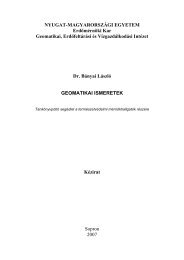COMPARING LIDAR DTM WITH DEM-5 OF HUNGARY
COMPARING LIDAR DTM WITH DEM-5 OF HUNGARY
COMPARING LIDAR DTM WITH DEM-5 OF HUNGARY
You also want an ePaper? Increase the reach of your titles
YUMPU automatically turns print PDFs into web optimized ePapers that Google loves.
NEW HORIZONS IN CENTRAL EUROPEAN GEOMATHEMATICS, GEOSTATISTICS AND GEOINFORMATICS<br />
<strong>COMPARING</strong> <strong>LIDAR</strong> <strong>DTM</strong><br />
<strong>WITH</strong> <strong>DEM</strong>-5 <strong>OF</strong> <strong>HUNGARY</strong><br />
József Szatmári 1 , Nándor Szíjj 2 , László Mucsi 1 , Zalán Tobak 1 , Boudewijn van Leeuwen 1 , Csaba Lévai 2 , János Dolleschall 1<br />
1<br />
University of Szeged, Department of Physical Geography and Geoinformatics, Szeged, Hungary<br />
e-mail: dolleschall@gmail.com<br />
2<br />
Carto-Hansa Ltd., Budapest, Hungary<br />
Abstract<br />
Requirements for precise digital elevation data of varying levels of detail are being formulated for different<br />
fields of application, such as inland excess water research in the Maros- Körös Interfluve. In this<br />
study two different digital terrain models were compared: the <strong>DEM</strong>-5m of Hungary and <strong>DTM</strong>-1m (Digital<br />
Terrain Model) generated from Airborne Laser Scanned (ALS) data. ALS data as well as stereo aerial photographs<br />
were acquired for three different areas in November 2009. The ALS data set was used to create<br />
a 70 km 2 <strong>DTM</strong>-1m. The data set of <strong>DEM</strong>-5m used for comparison consisted of high resolution <strong>DEM</strong> derived<br />
from Hungarian topographic maps at scale 1:10000 and points of IV order triangulation network. The results<br />
were compared to both <strong>DEM</strong> generation techniques to the data received from in situ measurements.<br />
Visual and statistical assessments were made, including profile and contour comparisons, allowing the<br />
spatial variation in accuracy to be explored. A mean vertical difference of 0.3 m and a standard deviation<br />
of about 0.7 m were calculated. Maps of differences were created for all sites. The differences are both<br />
natural and antropogenic forms. These forms do not appear at <strong>DEM</strong>-5. And furthermore there is an error<br />
in <strong>DEM</strong>-5 which cannot be explained with surface forms. The digital terrain model <strong>DTM</strong>-1 that has been<br />
created incorporates natural geomorphological forms that are essential for inland excess water modelling<br />
and cannot be identified on the <strong>DEM</strong>-5 model of Hungary.<br />
Keywords: <strong>LIDAR</strong>, ALS, <strong>DEM</strong>, <strong>DTM</strong>, inland excess water, geomorphology<br />
1. Introduction<br />
Excess water is a serious hazard in several<br />
lowland European countries. However, the<br />
international scientific community considers<br />
it as a true Carpathian Basin placed<br />
problem both from a natural and a social<br />
point of view. The very compound ‘excess<br />
water problem’ raises the need for a<br />
complex research effort in order to find<br />
solutions. In Hungary the usual annual<br />
damage is approximately 100–150 M €,<br />
however in years with exceptionally high<br />
inundation-rates it can reach up to 500 M<br />
€. The May and Nov–Dec 2010 rainfall also<br />
caused inland excess water inundations<br />
151
József Szatmári, Nándor Szíjj, László Mucsi, Zalán Tobak, Boudewijn van Leeuwen, Csaba Lévai, János Dolleschall<br />
<strong>COMPARING</strong> <strong>LIDAR</strong> <strong>DTM</strong> <strong>WITH</strong> <strong>DEM</strong>-5 <strong>OF</strong> <strong>HUNGARY</strong><br />
over 167,000–300,000 ha and by 7 June 2010,<br />
extensive damage was caused not only to<br />
agriculture but also to transport and tourism.<br />
Low and flat alluvial planes near the<br />
river Tisza are a characteristic example of<br />
an area endangered by inner excess water.<br />
Detection of endangered areas and research<br />
into this problem can have great influence<br />
upon local organisations and individuals<br />
engaged in agriculture as well as on regional<br />
governments, considering the fact<br />
that Csongrád County is a mainly agriculturally<br />
oriented area.<br />
Changes in the mean value of climate<br />
variables such as temperature or precipitation<br />
may also be associated with a change<br />
in their distribution as well. The projected<br />
change in climate will significantly impact<br />
on the the hydrological cycle. Furthermore,<br />
it is expected that the magnitude and frequency<br />
of extreme weather events will<br />
increase, and that hydrological extremes<br />
such as inland excess water and droughts<br />
are likely to occur more frequently and<br />
be more severe. Based on the well established<br />
current trends of the global climate<br />
changes and their regional scale in the<br />
Carpathian Basin, it is reasonable to assume<br />
that the hydrological cycle will be<br />
accelerated along the river Tisza basin as<br />
well, with greater event variability and<br />
extremes. Therefore, in order to mitigate<br />
the consequences, the assessment of the<br />
impacts of climate change on key elements<br />
of the hydrological cycle as well as on the<br />
risk of different types of weather driven<br />
natural hazards in the Tisza valley is an<br />
essential point. Certain types of inland<br />
excess water can be forecast and those<br />
areas or points where action is needed to<br />
decrease or even avoid the damage can be<br />
directly determined both with the help of<br />
theoretical and practical means. This way,<br />
the risk of inundation can be mitigated<br />
in numerous occasions, and this could<br />
enhance a shift from a defensive-type of<br />
water management strategy towards a<br />
more provocative, more action-based strategy,<br />
in order to decrease or rather prevent<br />
the damage. The formation and effects of<br />
inland excess water and its hazards can<br />
be approached from various aspects and<br />
scientific fields.<br />
2. Study area and data<br />
The 70 km 2 study area is situated in the<br />
vicinity of the settlement of Batida, to the<br />
south of the town of Hódmezővásárhely<br />
and near Székkutas in the southern part<br />
of Tiszántúl (the region east of the River<br />
Tisza) in the Great Hungarian Plain. There<br />
are several abandoned river meanders in<br />
the area. Its maximum difference in elevation<br />
is ten meters. The area is covered by<br />
young alluvial deposits, on which vertisols<br />
and fluvisols were formed. Most of it<br />
is under agricultural cultivation. Because<br />
of its extreme mechanical properties—in<br />
large areas, the plasticity index (KA) is<br />
above 60 (cm 3 /gr)—the exceptionally bad<br />
permeability characteristics result in the<br />
accumulation of water in the lower areas.<br />
Apart from the bad soil characteristics,<br />
the area consists of very flat terrain with<br />
large local depressions, without run-off.<br />
The average groundwater level varies<br />
between two and four meters below the<br />
surface. Remnants of river meanders can<br />
also be found in the area. In these former<br />
meanders, the groundwater may reach<br />
the surface.<br />
One of the most important factors in<br />
inland excess water analyses is the relief<br />
(Pásztor et al., 2006; Rakonczai et al.,<br />
2001, 2003). Since there are only very small<br />
height differences involved in the occurrences<br />
of the inundations it is important<br />
to use a very high resolution digital elevation<br />
model (<strong>DEM</strong>). In Hungary, the<br />
highest resolution <strong>DEM</strong> available for the<br />
whole country is the <strong>DEM</strong>-5 model with a<br />
horizontal resolution of 5 m and a vertical<br />
accuracy of 0.7 m (Király, 2004; Winkler,<br />
2006; Winkler et al., 2006). The geomorphological<br />
forms, which are important<br />
in inland excess analyses, are not visible<br />
at this accuracy. Also digital elevation<br />
models derived from the contours of the<br />
1:10000 topographic maps do not have sufficient<br />
accuracy which would be needed<br />
in this study. To overcome this problem,<br />
on November 19, 2009, an airborne laser<br />
scanning flight was executed to collect<br />
<strong>LIDAR</strong> data over three areas in south-east<br />
Hungary. From a flying height of 1500m,<br />
70 km 2 of terrain was surveyed with an<br />
average point density of 1.4 points/m 2 . In<br />
total 106 million points were measured.<br />
The accuracy of the <strong>LIDAR</strong> points was<br />
evaluated on two test areas for a total<br />
Table 1. – Accuracy of <strong>LIDAR</strong> data on pre-measured control points<br />
number of points of 15,000. The RSME<br />
error for the total amount of points was 4.6<br />
cm, while 99.76% of all points were within<br />
the specified vertical system accuracy of<br />
15 cm. The maximum vertical error was<br />
found to be 22 cm (Table 1).<br />
At the same time as the height recordings,<br />
stereo colour and near infrared aerial<br />
digital photographs were collected with<br />
a digital mapping frame camera (DMC).<br />
The resolution of the aerial photographs<br />
was 15 cm. The images were collected with<br />
a 30% overlap in the flight direction and<br />
60% overlap between consecutive flight<br />
lines. The images were geometrically corrected<br />
using geodetic base points with a<br />
known location, which were highlighted on<br />
the ground, and selected points that were<br />
measured with geodetic instruments after<br />
the flight and the accuracy of the <strong>LIDAR</strong><br />
points was evaluated based on these points<br />
too (Table 2).<br />
Study area Number of Max. Min. Arithmetic- Root-Meansquare<br />
Standard<br />
ALS points<br />
Mean<br />
Deviation (%)<br />
[cm] [cm] [cm] [cm] [cm]<br />
Székkutas 6820 22.0 -18.0 0.1 5.1 5.1 99.76<br />
Batida-<br />
Tápairét<br />
8479 15.0 -18.0 -0.3 4.1 4.1 99.96<br />
Where: ΔH = H lidar – H igm _ <strong>DTM</strong><br />
H igm <strong>DTM</strong> = interpolated geodetic measurements<br />
Table 2. – Accuracy of <strong>LIDAR</strong> data on vertical ground control points<br />
Study area<br />
Number of ALS<br />
points<br />
Max.<br />
[cm]<br />
Min.<br />
[cm]<br />
Root-Meansquare<br />
[cm]<br />
Batida- Tápairét Székkutas 11 26.0 -20.0 10.7 11.1<br />
Where: ΔH = H lidar – H ver<br />
H ver = vertical GCPs measured by RTK GNSS<br />
Standard<br />
Deviation<br />
[cm]<br />
152 153
József Szatmári, Nándor Szíjj, László Mucsi, Zalán Tobak, Boudewijn van Leeuwen, Csaba Lévai, János Dolleschall<br />
<strong>COMPARING</strong> <strong>LIDAR</strong> <strong>DTM</strong> <strong>WITH</strong> <strong>DEM</strong>-5 <strong>OF</strong> <strong>HUNGARY</strong><br />
Based on the aerial photographs, linear<br />
features were digitized in three dimensions<br />
with stereo-photogrammetric methods<br />
(Fig. 1). Based on this data, a 1 m resolution<br />
digital elevation model (<strong>DTM</strong>-1) was<br />
created (Fig. 2).<br />
Fig. 1. – The results of 3D vector measurements<br />
based on stereo images<br />
Fig. 2. – <strong>DTM</strong>-1 meter resolution model of 70 km 2<br />
study regions<br />
3. Comparison of two different<br />
height model<br />
We have compared the Hungarian <strong>DEM</strong>-5<br />
model (with a horizontal resolution of 5 m<br />
and a vertical accuracy of 0.7 m) and <strong>DTM</strong>-1<br />
generated from ALS data. Table 3 contains<br />
the differences of the same points in the<br />
two models (relative errors) in the different<br />
areas. During the comparison <strong>DEM</strong>-5 was<br />
subtracted from <strong>DTM</strong>-1 (DIFF = <strong>DTM</strong>1 –<br />
<strong>DEM</strong>-5). If the difference is below 0, then<br />
the surface of <strong>DTM</strong>-1 is under the surface<br />
of <strong>DEM</strong>-5 and if the difference is above<br />
0, then the surface of <strong>DTM</strong>-1 is above the<br />
surface of <strong>DEM</strong>-5.<br />
Difference maps were also created for the<br />
three areas. The differences are both natural<br />
and anthropogenic forms. The negative<br />
differences are old river channels, artificial<br />
channels, and small local holes. The<br />
positive differences are dikes of dirt roads,<br />
accumulations by old river channels, and<br />
small local hills.<br />
Nevertheless there is a huge positive difference<br />
(almost 15 m) to the NE of Tápairét<br />
(Fig. 3). This area was examined in an ortophoto.<br />
On the basis of this ortophoto (Fig.<br />
4) it is clear that this difference is caused<br />
by the construction of a highway, more<br />
precisely, the construction of a bridge. So<br />
this difference is not an error of <strong>DEM</strong>-5,<br />
because the elevation in this area shows<br />
the height of a bridge, not the surface.<br />
There is also a negative difference in<br />
Batida which cannot be explained with the<br />
forms mentioned above. In the South of the<br />
area there are two rectangle-like shapes<br />
(Fig. 5) with a 2–4 m negative difference<br />
(the <strong>DTM</strong>-1 is under the <strong>DEM</strong>-5).<br />
It is important to know that Batida is<br />
an archeological area, so it is very likely<br />
that these differences are caused by archeological<br />
work. On the basis of Fig. 6 it<br />
is unquestionable that the upper layer of<br />
Table. 3. – Differences between <strong>DTM</strong>-1 and <strong>DEM</strong>-5<br />
Székkutas Batida Tápiarét<br />
Number of compared points 1 197 760 767 255 829 316<br />
Maximum positive difference (m) + 4.4 + 3.9 + 9.0<br />
Maximum negative difference (m) - 2.8 - 6.2 - 7.3<br />
Mean (m) - 0.05 + 0.05 - 0.29<br />
Standard Deviation (m) 0.37 0.49 0.65<br />
Fig. 3. – The difference of the two models in Tápairét, the circle shows<br />
the almost 15 meters difference<br />
Fig. 4. – The area of the15 meters difference in ortophoto<br />
the soil has been removed<br />
and field examinations also<br />
confirmed that this difference<br />
was caused by archeological<br />
excavation. So it is<br />
important to note that this<br />
difference is not an error of<br />
<strong>DEM</strong>-5 either, because it is<br />
an anthropogenic form.<br />
Finally, the differences between<br />
the two models were<br />
examined in Székkutas as<br />
well. The positive differences<br />
are dikes of dirt roads<br />
and small local hills just as<br />
in the other two cases. The<br />
negative differences are<br />
mostly small local holes.<br />
However, there is a large<br />
area with more than 1 m<br />
negative difference in the<br />
SW part of the study area<br />
(Fig. 7).<br />
The shape of this area<br />
is more than 1000 meters<br />
wide in the SW–NE direction.<br />
The area was examined<br />
first in an ortophoto<br />
(Fig. 8) then on the field, but<br />
there was no geomorphological<br />
or anthropogenic<br />
form which could explain<br />
this difference. According<br />
to the accuracy check mentioned<br />
above, the elevation<br />
of the <strong>DTM</strong>-1 is very close<br />
to the real elevation of the<br />
surface. So the question<br />
is: what is wrong with the<br />
<strong>DEM</strong>-5 model? <strong>DEM</strong>-5 was<br />
derived from Hungarian<br />
topographic maps at a scale<br />
of 1:10000 and points of the<br />
IV order triangulation network,<br />
so the area was also<br />
154 155
József Szatmári, Nándor Szíjj, László Mucsi, Zalán Tobak, Boudewijn van Leeuwen, Csaba Lévai, János Dolleschall<br />
<strong>COMPARING</strong> <strong>LIDAR</strong> <strong>DTM</strong> <strong>WITH</strong> <strong>DEM</strong>-5 <strong>OF</strong> <strong>HUNGARY</strong><br />
Fig. 5. – The difference of the two models in Batida<br />
This area can be easily found in the<br />
<strong>DEM</strong>-5 model (Fig. 10). According to<br />
the model in this area there has to be a<br />
higher elevation than in the surrounding<br />
areas. So—on the basis of these investigations—it<br />
is very likely that this<br />
difference is caused by an interpolation<br />
error.<br />
On the basis of the comparison in these<br />
three areas, <strong>DTM</strong>-1 incorporates natural<br />
geomorphological forms and anthropogenic<br />
objects that are essential for inland<br />
excess water modelling and these cannot be<br />
identified on the <strong>DEM</strong>-5 model of Hungary,<br />
e.g. old river channels, local holes, artificial<br />
channels, etc.<br />
But on the basis of the 70 km 2 area examined<br />
(with 70 million points), the mean<br />
accuracy of <strong>DEM</strong>-5 is better than 70 cm, but<br />
<strong>DEM</strong>-5 also contains pixels with an error<br />
larger than one meter, e.g. the interpolation<br />
error mentioned above.<br />
Fig. 8. – The SW of Székkutas in ortophoto with the<br />
contours of the negative difference<br />
excess water investigations. The missing<br />
forms of <strong>DEM</strong>-5 are mainly linear natural<br />
and antropogenic forms. The digital<br />
terrain model <strong>DTM</strong>-1 that has been created<br />
incorporates geomorphological forms<br />
that are essential for inland excess water<br />
modelling and cannot be identified on the<br />
<strong>DEM</strong>-5 model of Hungary.<br />
These results will be a significant help to<br />
the water management authorities and affected<br />
population in both preventive and<br />
operative actions. These and the use of<br />
the enormous quantity of data, information,<br />
and knowledge previously accumulated<br />
by the related fields according to the<br />
newly outlined schemes and aspects may<br />
lead to a long term solution for this perennial<br />
problem. The integration of modern<br />
and traditional tools and approaches<br />
is the key for generating a change in the<br />
strategy of excess water management.<br />
Fig. 6. – The archeological area in ortophoto<br />
Fig. 7. – The difference of the two models in Székkutas,<br />
the circle shows the negative difference<br />
examined in a topographic map (Fig. 9).<br />
But this difference cannot be explained by<br />
the contours of the topographic map either.<br />
4. Summary<br />
Inland excess water is a serious hazard<br />
and is currently a problem in Hungary,<br />
particularly in Csongrád County. This<br />
research aims at the solution of several<br />
interrelated questions with the means of<br />
both fundamental and applied research in<br />
the areas of Marosszög. First, we intended<br />
to examine the formation of the different<br />
types of excess waters. We would like to<br />
find and test a novel methodology for the<br />
field mapping of inundations, which will<br />
include the verification of remotely sensed<br />
data on test sites, in order to evaluate their<br />
use in excess water protection works.<br />
We have proved by visual and statistical<br />
assessments, including profile and contour<br />
comparisons, that the ALS survey with<br />
an average point density of 1.4 points/m 2<br />
is a proper base for terrain modelling in<br />
Fig. 9. – The SW of Székkutas in 1:10000 topographic<br />
map<br />
Fig. 10. – The problematic area in the <strong>DEM</strong>-5 model,<br />
the circle shows the difference<br />
Acknowledgement<br />
This research was financially supported by<br />
the project “Development of an INLAND<br />
EXCESS WATER-INFO system” (Economic<br />
Operative Program: GOP - 1.1.1 - 08 / 1<br />
-2008 – 0025). We have used the <strong>DEM</strong>-5<br />
data with permission of Péter Winkler<br />
(Institute of Geodesy, Cartography and<br />
Remote Sensing).<br />
156 157
József Szatmári, Nándor Szíjj, László Mucsi, Zalán Tobak, Boudewijn van Leeuwen, Csaba Lévai, János Dolleschall<br />
References<br />
Király, G. (2004): Domborzatmodellek előállításához felhasználható forrásadatok összehasonlító vizsgálata.<br />
HUN<strong>DEM</strong> 2004, Miskolc, CD kiadvány.<br />
Pásztor, L., Pálfai I., Bozán, Cs., Kőrösparti, J., Szabó, J., Bakacsi, Zs., Kuti, L. (2006): Spatial stochastic<br />
modelling of inland inundation hazard. 9th AGILE Conference on Geographic Information Science,<br />
Visegrád, Hungary, 139–143.<br />
Rakonczai J., Mucsi L., Szatmári J., Kovács F., Csató Sz. (2001): A belvizes területek elhatárolásának módszertani<br />
lehetőségei. A földrajz eredményei az új évezred küszöbén. A Magyar Földrajzi Konferencia (CD), Szeged.<br />
Rakonczai, J., Mucsi, L., Csató, Sz., Kovács, F., Szatmári, J. (2003): Az 1999. és 2000 évi alföldi belvízelöntések<br />
kiértékelésének gyakorlati tapasztalatai. Vízügyi Közlemények Különszám, 4, 317–336.<br />
Winkler, P. (2006): Nagyfelbontású digitális domborzat modell az ország teljes területére (ELK-DDM-51).<br />
Termékismertető,<br />
Winkler, P., Iván, Gy., Kay, S., Spruyt, P., Zielinski, R. (2006): Űrfelvételekből származtatott digitális felületmodell<br />
minőségének ellenőrzése a magyarországi nagyfelbontású digitális domborzatmodell alapján.<br />
Geodézia és Kartográfia, 2, 22–31.<br />
158


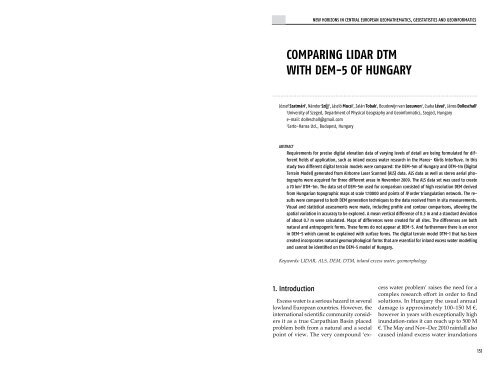

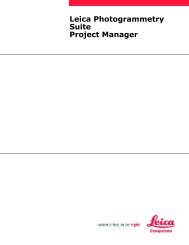
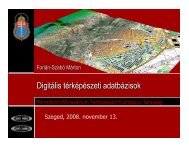

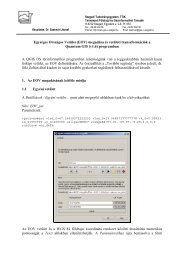
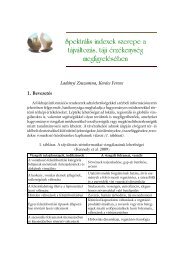
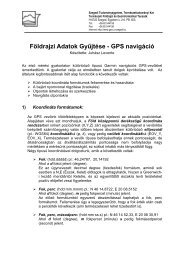
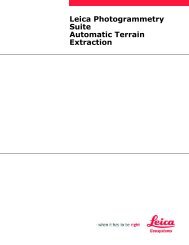
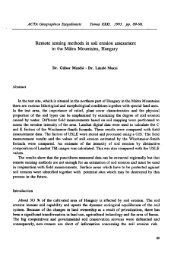
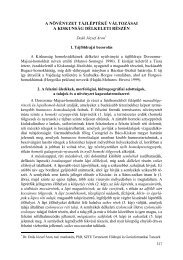
![TAVAK [Kompatibilitási mód]](https://img.yumpu.com/31087107/1/190x135/tavak-kompatibilitasi-mad.jpg?quality=85)
